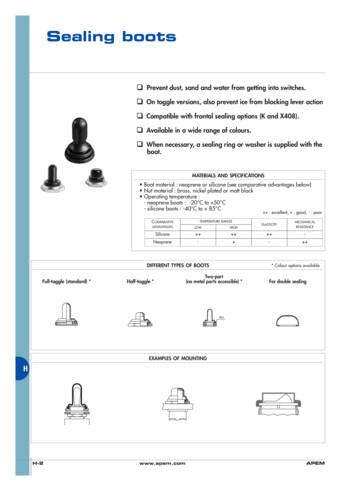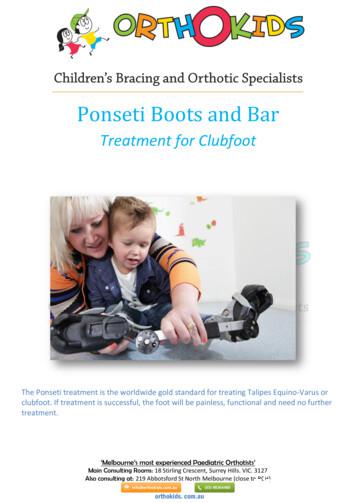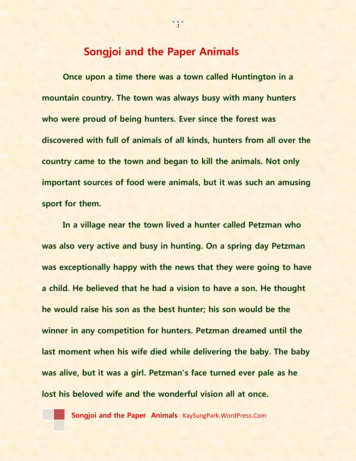Polyurethane Protective Boots - Aircraft Spruce
3Polyurethane Protective BootsTechnical BulletinOctober 2007Product Description3M Polyurethane Protective Boots SJ8542HS, SJ8545HS, SJ8641, SJ8663, SJ8663HS,SJ8665, SJ8667HS, SJ8671, SJ8672 and SJ8681HS are made of an abrasion-resistantpolyurethane and are resistant to ultraviolet light. They can be painted or applied over paintedsurfaces. They are available in a variety of shapes and colors for many industrial and commonaircraft applications (including radomes, wing tips, landing gear pods, etc.). The product isconstructed with a long-aging, solvent-resistant, pressure-sensitive acrylic adhesive, andprotected with an easy-release liner.Typical PhysicalProperties andPerformanceCharacteristics for3M SJ8665 BootNotes: 1) The following technical information and data should be considered representative or typical onlyand should not be used for specification purposes.2) ASTM American Society for Testing and Materials.3) Metric values are listed in parenthesis.A. DimensionsApproximate Applied Thickness:*0.012 inch (0.30 mm) FilmTotal thickness 0.014 inch (0.36 mm)Approximate Weight:0.09 lb/ft2 (440 g/m2)*There is a gradual decrease in thickness, 0.009 in (0.23 mm) minimum overall, at the base of the boot.B. Typical Physical Properties and Performance Tensile Strength @ BreakASTM D882lb/in (N/100 mm)94 (1646)Elongation % @ BreakASTM D882%458H-18, 1000g wt,1000 cycleLoss in grams 0.10HardnessASTM-D2240Shore A80Dielectric StrengthASTM-D1000Volts14,000Dielectric Constant@ 5.6 GHz@12.8 GHz–3.0182.940ASTM D-100024 Hr. Dwelloz/in (N/100 mm)92.6 (101.4)68.3 (74.8)111.5 (122.0)78.8 (86.3)77.1 (84.4)108.2 (118.4)Taber AbrasionPeel Adhesion @ 70 F (21 C) to:AluminumGlassEpoxy PrimerUrethane PaintHigh Solids Mil Spec PaintHigh Solids Mil Spec Paint(w/3M Promoter #86)Solvent ResistanceMotor OilDistilled WaterHydraulic Fluid**JP-4/JP-5 Aviation FuelDiesel Fuel24 hourimmersionLittle or no apparent effectLittle or no apparent effectLittle or no apparent effectSlight edge penetrationSlight edge penetration**3M Polyurethane Protective Boots are not resistant to Skydrol hydraulic fluid. Edge sealing with 3M Scotch-Weld Epoxy Adhesive DP190 can significantly reduce the effect of Skydrol migrating under edges of boot and tape.
Technical BulletinPolyurethane Protective TapeTypical PhysicalProperties andPerformanceCharacteristicsFor typical physical and performancecharacteristics 71SJ8672SJ8681HSrefer to technical data pages for 3M Polyurethane Protective SEnvironmental Healthand SafetyBefore handling any chemical products, always read the container label and the MSDS.Local air quality regulations may regulate or prohibit the use of surface preparation andcleaning materials based on solvent (VOC) content.Suggested SurfacePreparation ProceduresAlthough this procedure refers to a “radome” structure, the procedure is valid for othertypes of structures such as wing tips, drop tanks, navigational light lens, etc.The radome must be in good condition before a boot is applied. The surface must besmooth without dirt or paint “nibs”. If defects are present in the paint, lightly sand thepaint with 320 grit sandpaper. If there is a multicolor paint scheme on the radome insurethat there are no paint edges to interfere with the adhesion of the boot in these areas. Paintlines can be minimized by the use of Scotch Fine Line Tape 218 during the paint process.Paint lines can be reduced after paint cure by light sanding with 320 grit sandpaper. Lossof gloss during any sanding process will not be noticeable after the boot is applied. Freshlypainted radomes, should be allowed to cure or dry for a minimum of 48 hours at 72 F(22 C). Paint cure can be accelerated by baking the radome at 150 F (66 C) for 8 hours.Removal ofExisting Boot1. Lift an edge of the boot by slowly, carefully peeling back the boot at 180 (back againstitself).2. To make the removal easier, soften the adhesive by using a wallpaper steamer (warmboot to 120 F [49 C]) or using hot water and a sponge.3M Tape and Residue Remover can also be used to remove the Boot in its entirety.-2-
Technical BulletinPolyurethane Protective TapeSuggested InstallationProceduresNote: This installation procedure does not apply to 3M Polyurethane Protective BootSJ8641. See authorizing installation documents or 3M Polyurethane ProtectiveTape 8641 technical datasheet for installation instructions.Step 1: Make sure hands are clean and free of oilsand grease. Clean the radome/part and the boot (topside and bottom side) with 3M Protective TapeApplication Solution to remove the corn starch.This will ensure maximum adhesion.Note: Use a clean, lint-free, silicone-free cloth orcheese cloth. Do not use shop rags as they might becontaminated with silicones.Step 3: Position the boot over the radome/part(adhesive/white liner side down against radome/part).Measure from the bottom of the boot and the base ofthe radome/part to ensure it is centered and properlypositioned.Step 2: Trim the boot with a pair of scissors about 1/4inch above the trim line (trim line is located 1/2 inchabove the base) that is found on most boots. Makeclean, smooth cuts - avoid jagged edges.Note: To document the installation in the aircraft logbooks, save the boot identifier tag that is on the baseof the boot.Step 4: Use 3M Vinyl Tape 471 to mark three indexpoints on the radome/part (one on the top and two onthe sides approximately 90 apart) clearly establishingthe center point, so the boot can be repositionedproperly. Then mark three additional index points onthe boot opposite of marks currently in place.Step 5: Remove the boot from the radome/part andturn the boot inside out taking care not to wrinklethe boot.Step 6: Spray the radome/part and boot with 3MApplication Solution. Then place the boot back on theradome (liner will be facing up). Using thumb nail, liftedge of liner from the boot to expose a small portionof adhesive. Spray 3M Application Solution on theadhesive. When removing the remainder of the liner,continuously spray 3M Application Solution on theexposed boot.-3-Note: Using the radome/part as a holder for the boot isimportant when removing the liner. This prevents theboot from sticking to itself - making it unusable.
Technical BulletinPolyurethane Protective TapeSuggested InstallationProcedures (continued)Step 7: Remove the 3M Polyurethane ProtectiveBoot from the radome/part, turn inside out again.The adhesive side should be facing the radome/part.Heavily spray radome/part and boot with 3M Protective Tape Application Solution allowing foreasy repositioning. The more 3M ApplicationSolution used, the easier the application will be.Step 8: Apply the boot to the radome/part taking careto match the index points at the top and sides of theboot. Reposition and reapply 3M Application Solutionas needed until proper fit is achieved. Remove indexmarks.Step 9: Reapply 3M Application Solution to theoutside of the boot. Starting at the center of theradome/part, use 1-2 inch strokes with the yellowsqueegee to smooth out the boot - removing thetrapped 3M Application Solution and air bubbles.Apply only light pressure to squeegee.Step 10: Continue using short strokes working yourway down to the base. If a bubble is trapped, carefullypeel boot back, reapply 3M Application Solution anduse yellow squeegee to re-adhere. Use a clean, lintfree, silicone-free cloth to absorb the liquid at theedges of the boot. This helps the edge of the boot tostay attached to the surface of the radome/part.Note: Small bubbles ( 1/8 inch) will evaporate bythemselves in less than one week. These small bubblescan be removed by using a small 1 cc syringe ifnecessary; however, this procedure should be kept toan absolute minimum and should not be used in thecenter, blunt frontal area of the boot.Step 11: Dry the surface of the boot with a cleancloth. If the boot is installed on an aircraft, allow todwell one hour at 70 F (21 C) before flight.-4-
Technical BulletinPolyurethane Protective TapeSpecial Note forTreatment of DiverterStrips on AircraftRadomesIf static diverters are present on the radome, either segmented or solid diverters, you mustnot cover them with the 3M Polyurethane Protective Boot. Apply the 3M Boot asdescribed on pages 3 & 4, carefully trim the material of the 3M Boot from the edge of thediverter strip using small scissors. Take extreme caution not to score or cut or otherwisedamage the paint on the radome. When this trimming operation is complete, finish by neatlyapplying 3M Scotch-Weld Epoxy Adhesive DP-190 to seal the edges of the 3M boot tothe radome around the cutout for the diverter. Masking tape works well to insure a neatapplication of the edge sealant.Painting3M Polyurethane Protective Boots may be painted per 3M Technical BulletinPolyurethane Protective Tape, Paint Instructions (70-0702-6358-0).Authorization to UseThe FAA has classified the installation of a 3M Boot as a minor modification. It is consideredto be similar to a thick coat of paint. See FAA letter as follows:-5-
Technical BulletinPolyurethane Protective TapeSafety and Regulatory 3M Polyurethane Protective Boots are 100% solids and contain no hazardous air pollutants(HAPs), volatile organic components (VOCs) or materials restricted by regulations or law. Polyurethane Protective Boots meet US Federal and California regulations for landfillable materials.The product is potentially recyclable. Packaging materials meet US Federal and California regulations for landfillable materials and arerecyclable or reusable. This product is considered to be an article that does not release or otherwise result in exposure to ahazardous chemical under normal use conditions. When using solvents, extinguish all ignition sources, inlcuding pilot lights. Read and followmanufacturer's warnings and directions for use. Before using solvents, consult local air quality rules and regulations which may regulate solvent use.Shipping and StorageNo special/hazardous labeling or packaging required and no regulations for air, ground or watershipment for this product.Keep film in a clean area, away from excessive moisture and out of direct sunlight. Store rolls inthe shipping carton. Return partially used rolls to the shipping carton.Shelf life: Two (2) years from date of manufacture.PrecautionaryInformationRefer to Product Label and Material Safety Data Sheet for health and safety information before using thisproduct. For additional health and safety information, visit www.3M.com/msds or call 1-800-364-3577 or(651) 737-6501.For AdditionalInformationIn the U.S., call toll free 1-800-235-2376 or fax 1-800-435-3082 or 651-737-2171. For U.S. Military, call1-866-556-5714. If you are outside of the U.S., please contact your nearest 3M office or one of thefollowing branches:AustraliaAustriaBrazilCanada61-2-498-9711 tel01-86686-298 tel55 19 3838-7876 tel800-410-6880 ext. 6018 tel61-2-498-9710 fax01-86686-229 fax55 19 3838-6892 fax800-263-3489 faxChinaDenmarkFranceGermany86-21-62753535 tel45-43-480100 tel0810-331-300 tel02131-14-2344 tel86-21-62190698 fax45-43-968596 fax30-31-6195 fax02131-14-3647 faxItalyJapanKoreaNetherlands02-7035-2177 tel03-3709-8245 tel02-3771-4114 tel31-71-5-450-272 tel02-7035-2125 fax03-3709-8743 fax02-786-7429 fax31-71-5-450-280 faxSouth AfricaSpainSwitzerlandUnited Kingdom11-922-9111 tel34-91-321-6000 tel01-724-9114 tel(0) 161-237-6174 tel11-922-2116 fax34-91-321-6002 fax01-724-9068 fax(0) 161-237-3371 faxImportant Notice3M MAKES NO WARRANTIES, EXPRESS OR IMPLIED, INCLUDING, BUT NOT LIMITED TO,ANY IMPLIED WARRANTY OF MERCHANTABILITY OR FITNESS FOR A PARTICULARPURPOSE. User is responsible for determining whether the 3M product is fit for a particular purposeand suitable for user’s method of application. Please remember that many factors can affect the use andperformance of a 3M product in a particular application. The materials to be bonded with the product, thesurface preparation of those materials, the product selected for use, the conditions in which the product isused, and the time and environmental conditions in which the product is expected to perform are amongthe many factors that can affect the use and performance of a 3M product. Given the variety of factorsthat can affect the use and performance of a 3M product, some of which are uniquely within the user’sknowledge and control, it is essential that the user evaluate the 3M product to determine whether it is fitfor a particular purpose and suitable for the user’s method of application.Limitation of Remediesand LiabilityIf the 3M product is proved to be defective, THE EXCLUSIVE REMEDY, AT 3M’S OPTION, SHALLBE TO REFUND THE PURCHASE PRICE OF OR TO REPAIR OR REPLACE THE DEFECTIVE3M PRODUCT. 3M shall not otherwise be liable for loss or damages, whether direct, indirect, special,incidental, or consequential, regardless of the legal theory asserted, including, but not limited to, contract,negligence, warranty, or strict liability.This product was manufactured under a 3M quality standard registered under AS9100 standards.3Aerospace and Aircraft Maintenance Division3M Center, Building 223-1N-14St. Paul, MN 55144-10001-800-235-2376www.3M.com/aerospacePlease Recycle. Printed in U.S.A. 3M 2007 (10/07)70-0707-3821-9Skydrol is a registeredtrademark of Solutia, Inc.3M and Scotch-Weld aretrademarks of 3M.
Painting 3M Polyurethane Protective Boots may be painted per 3M Technical Bulletin Polyurethane Protective Tape, Paint Instructions (70-0702-6358-0). Authorization to Use The FAA has classified the installation of a 3M Boot as a minor modification. It is considered to be similar to a thick coat of paint. See FAA letter as follows:
The list of boots has expanded and will continue to be updated as new boots are certified. See NAVADMIN 214/17 for the initial list of authorized boots. Optional Boots listed may require Commanding Officer guidance and authorization for wear Black Leather Safety Boots B. Bates Shoe Company, Style 1621 (Men) (Certificate Number 15B30-002034-
AC.FLATS 17 (.669) HEX NUT Nickel plated Matt black HALF-TOGGLE SILICONE BOOTS Black Red Green White For bushing Ø12 x 0.75 SI (.472x.075 IS) - 4450, 4650 and 1600 series 18.90 (.744) AC.FLATS 17 (.669) HEX NUT Nickel plated Matt black FULL-TOGGLE BLACK NEOPRENE BOOTS N36116045 (U09) N36116042 (U223) 22.
The boots and bar hold the feet in the position needed to stop the muscles and ligaments becoming tight again after the foot has been corrected. Without the Boots and Bar, the chance of relapse is very high. How Long Will My Child Wear the Boots and Bar? For the first three months after plasters, the Boots and Bar is worn twenty-three hours per .
Trekking boots 8000m mountaineering boots 6000m mountaineering boots (Optional) Snow gaiters Down bivvy boots amp boots (Optional) Foot-warming system (Optional) 5.0 Packs & Bags Small lockable duffel bag x 1 (30-40 litres) Large lockable duffel bags x 2 (2 x 95-132 litres) Daypack (30-45 litres)
- B734 aircraft model added - B735 aircraft model added - E145 aircraft model added - B737 aircraft model added - AT45 aircraft model added - B762 aircraft model added - B743 aircraft model added - Removal of several existing OPF and APF files due to the change of ICAO aircraft designators according to RD3: A330, A340, BA46, DC9, MD80
Middle has size 3 boots. They are one and a half times the length of Little’s boots. Big has size 5 boots. A little boot and a middle boot are the same length as a big boot. They start with the heels of their boots on the same line. Solve mathematical problems or puzzles. Recognise multiples of 2, 3
The "fitter boots" we send to you are an actual pair of our hand-made boots, and the size we send is based on the outlines and measurements you have previously sent back to us. These boots are made on a "clean" boot form, and they will help us to confirm your correct measurements. "Fitter boots" are not intended to be a perfect fit, but they
a paper animal. She tried over and over until she could finally fold a paper dog and wished that she could see Son just once more even though she knew that it was not possible. Looking at the paper dog she had made, she felt so weird that the paper dog seemed smiling at her. She felt that she would make more, many more animals out of paper. She collected all the papers in the house and started .























